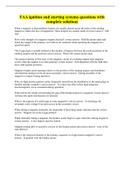FAA ignition and starting systems
Liberty University
Here are the best resources to pass FAA ignition and starting systems. Find FAA ignition and starting systems study guides, notes, assignments, and much more.
All 1 results
Sort by

-
FAA ignition and starting systems questions with complete solutions
- Exam (elaborations) • 3 pages • 2023
-
- $8.49
- + learn more
When a magneto is disassembled, keepers are usually placed across the poles of the rotating magnet to reduce the loss of magnetism. These keepers are usually made of correct answer: Soft iron
How is the strength of a magneto magnet checked? correct answer: Hold the points open and check the output of the primary cool with an AC ammeter while operating the magneto at a specified speed
The E-gap angle is usually defined as the number of degrees between the neutral position of the rotating ...
Exam (elaborations)
FAA ignition and starting systems questions with complete solutions
Last document update:
ago
When a magneto is disassembled, keepers are usually placed across the poles of the rotating magnet to reduce the loss of magnetism. These keepers are usually made of correct answer: Soft iron How is the strength of a magneto magnet checked? correct answer: Hold the points open and check the output of the primary cool with an AC ammeter while operating the magneto at a specified speed The E-gap angle is usually defined as the number of degrees between the neutral position of the rotating ...
$8.49
Add to cart

Make study stress less painful
Study stress? For sellers on Stuvia, these are actually golden times. KA-CHING! Earn from your study resources too and start uploading now. Discover all about earning on Stuvia
Study stress? For sellers on Stuvia, these are actually golden times. KA-CHING! Earn from your study resources too and start uploading now. Discover all about earning on Stuvia


